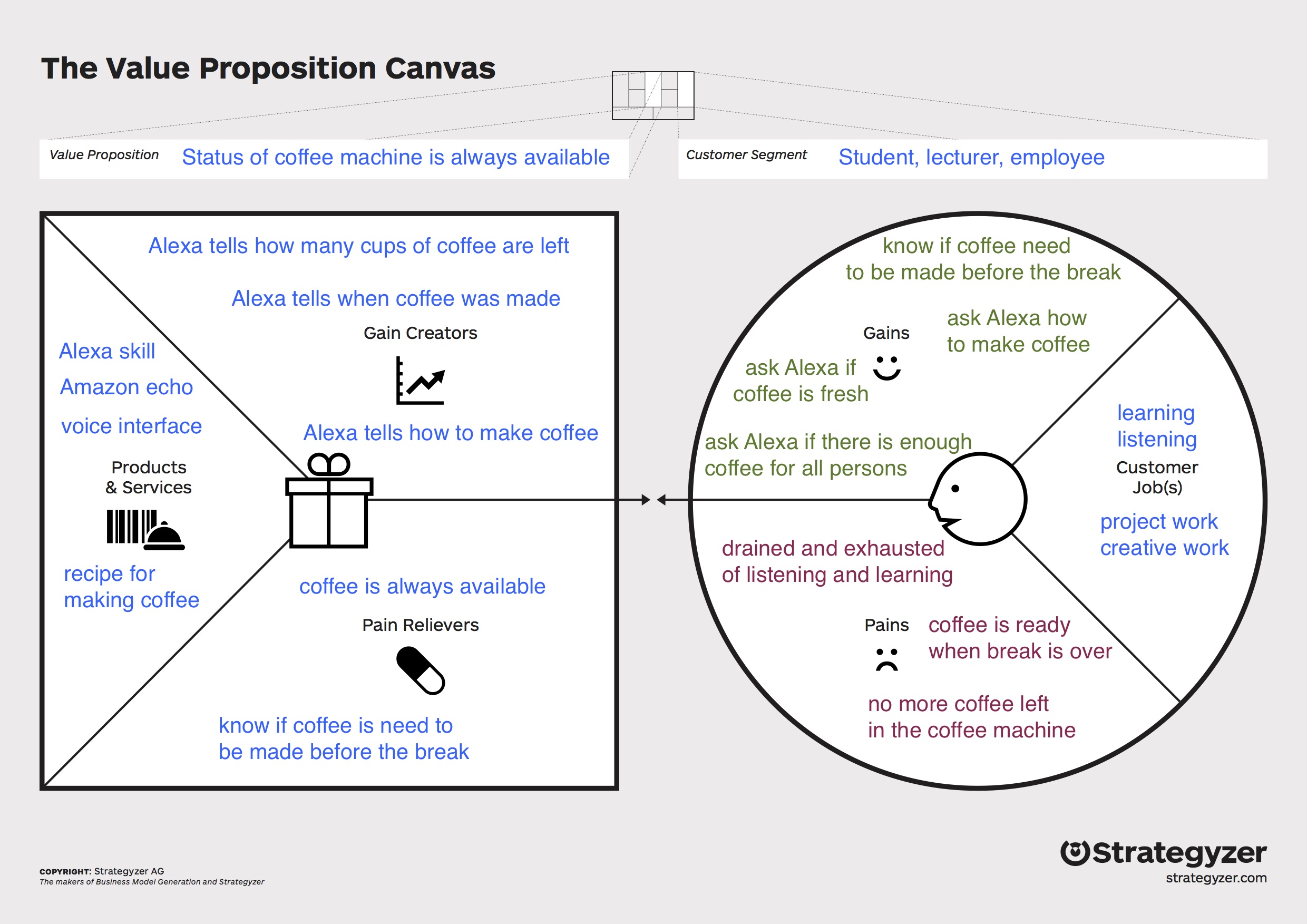1: Introduction, VPC and MVP - GharbiRaouf/hhz_hackathon_alexa_coffee GitHub Wiki
Introduction
Being a student or employee at Herman-Hollerith-Zentrum means challenging a constant process of innovation. The coffee machine represents a spot for spontaneous meetings to talk about the latest technological trends, but also a place for recreation and relaxation. At the beginning of the project we started to brainstorm about how to support the creative process of innovation with a new service within the university environment. Using Amazon Alexa seemed to be an intelligent solution to communicate with the frequently used old analogous coffee machine in the kitchen of HHZ. Cooperating with another team which implemented a process to weigh the amount of coffee we had a solid foundation to develop a service via voice interface using Alexa skills. Before starting to implement or develop we used the Value Proposition Canvas by Osterwalder to figure out which steps have to be taken. No matter if student or lecturer, every member knows the situation when a cup of coffee makes learning or working much easier. Therefore, we started to create services supported by Amazon echo. The value proposition exists in the status of the coffee machine which is always available. Alexa shall answer if there is enough coffee for all persons or when coffee was made to know if it still fresh and delicious. Also asking Alexa for help making fresh coffee is a service we wanted to implement.
MVP
As there are no sensors, controller or gateway needed to be implemented for the hackathon project, we decided to focus on the elaboration of the service design. The Amazon echo represents the only touch point between the user and backend architecture. Therefore, the service idea consists of three parts:
When was coffee made? By querying the database for the last filling of the coffee pot this question can be easily answered by Alexa. The only calculation is the difference of the current time and the timestamp of the last padding.
How much coffee is left? Therefore the actual amount of coffee need to be provided. The added value here is to give information that a certain number of cups is still available. For this the weight of the empty coffee pot need to be subtracted from the actual measured value. Assumptioned that cooked coffee weights the same as water, the value can be directly transferred from the unit kilogram into liter. Afterwards the value can be divided by the average capacity of a coffee cup, e.g. 200 ml. The result can be used to let Alexa answer the questions “how much coffee is left?”, “how many cups of coffee are still available?” or even “is enough coffee available for 5 persons”.
How to make coffee? To let Alexa answer this question no computation or database querying is needed. Simply the printed manual in the kitchen of HHZ need to be summed up in a few sentences and read out by Alexa.
VPC

For customer jobs we decided to select students as the only customer segment and to neglect the customer segments lecturer and employe. Therefore, the most significant customer jobs are learning and listening on the one hand, and project work and creative work on the other hand.
Into the 'Pains' segment of the VPC we insert real world problems of students. After a draining and exhausting lecture often no more coffee is left and have to be made fresh. It takes long time to make coffee because of the lange amount of water. In the worst case break is over when coffee is ready for drinking.
Therefore we implement the services which are located in the 'Gains' segment von the VPC. Students and lecturers ask Alexa if there is enough coffee for all persons. The result is given in number of cups so coffee can be made before the break if not enough.
As the most important part of the 'Pain Relievers' segment we mention the claim that due to Alexa coffee is always available. Additionally Alexa tells when coffee was made and helps to make coffee by telling the instruction as we point out in 'Gain Creators'.
For 'Products & Services' an Alexa skill has to be implemented on the Amazon echo. Using the voice interface customers' needs can be satisfied. Furthermore the deterrent instruction for making coffee hanging out in the kitchen of HHZ can now be dictated by Alexa to encourage unexperienced students to make coffee on their own.
Business relevant contribution
As already shown, the most important service we implement is the remote communication with the simple coffee machine. Accordingly to this service, the formerly simple coffee machine gets smart. Using the partner group's scale and database a time function is now added. Also the voice interface, which is the only touchpoint between customers and background processes, enables the implementation of many services. We limit the range of services by letting Alexa answer the questions when (coffee was made), how much (coffee is left) and how (to make coffee).